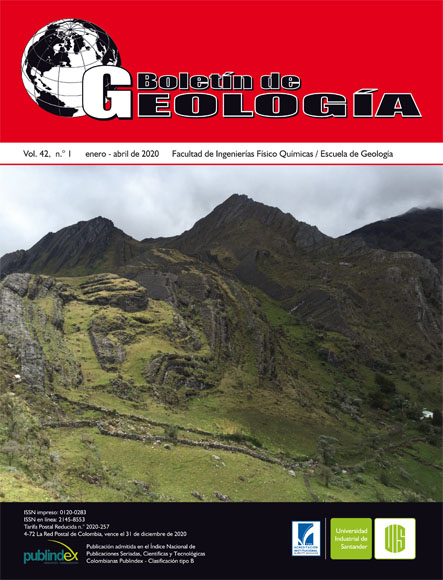Petrophysical characterization as a potential reservoir of the siliciclastic paleogenes sucesions of the ANH-TIERRALTA-2-X-P well in the Sinú-San Jacinto Basin, colombian Caribbean
Published 2020-01-22
Keywords
- Sinú-San Jacinto,
- petrography,
- diagenesis,
- petrophysics
How to Cite
Altmetrics
Abstract
A petrophysical evaluation was carried out for the siliciclastic levels of the ANH-TIERRALTA-2-X-P well in the Sinú-San Jacinto Basin, Northwest of Colombia. The well was divided into five informal units that contain ten stratigraphic cycles based on the lithology and response of the gamma ray log. The fist from surface to 1100 ft (El Carmen Formation, Oligocene), the second (1100 ft - 3100 ft) composed of biomicrites (Tolúviejo Formation, Eocene). Unit 3 corresponds to quartzitic and lithic sandstones interbedded with shales (2000 ft thick); Unit 4 corresponds to conglomerate sandstones (5530 ft - 6620 ft); Unit 5 (6620 ft to 6770 ft) contains gray limestones; these last three, correlate with the San Cayetano Formation, from Paleocene. The basal unit (6770 ft to 8711 ft) contains dark gray shales, and correlates with the Cansona Formation of the Upper cretaceous. Petrographically, 26 thin sections of Cycle 8 (Unit 3) were analyzed. Early diagenesis is represented by compaction, alkali feldspar kaolinitization and plagioclase sericitization, and the burial diagenesis by neoformation of calcite cement. The basal siliciclastic cycles (4, 5 and 6 in Unit 4) are the most prospective for the accumulation of hydrocarbons, while Cycle 7 (in Unit 3) will correspond to the cap rock of the possible oil system. The shale volume was calculated from the gamma ray and density-neutron logs. The porosity calculations made from the density log (between 8 and 15%) are the closest to the values calculated in the laboratory from the recovered plugs (5%). The water saturation was estimated using the calculated porosity and the deep resistivity log, reporting an average value of 95% in potential reservoirs analyzed.
Downloads
References
ANH. (2014b). Pozo: ANH-TIERRALTA-2-X-P. Registro gráfico compuesto. Escala 1:500. Agencia Nacional de Hidrocarburos, Bogotá, Colombia.
ANH. (2016). Nuevas oportunidades exploratorias. Cuenca Sinú-San Jacinto. Agencia Nacional de Hidrocarburos, Bogotá, Colombia.
Archie, G.E. (1941). The electrical resistivity log as an Aid determining some reservoir characteristics. Transactions of the AIME, 146(1), 54-62. doi: 10.2118/942054-G.
Alfaro, E., and Holz, M. (2014). Review of the chronostratigraphic charts in the Sinú-San Jacinto basin based on new seismic stratigraphic interpretations. Journal of South American Earth Sciences, 56, 139-169. doi: 10.1016/j.jsames.2014.09.004.
Beard, D.C., and Weyl, P.K. (1973). Influence of texture on porosity and permeability of unconsolidated sand. AAPG Bulletin, 57(2), 349-369.
Beroiz, C., Linderberg, F., and Winter, S.R. (1986). Northwest Colombia Hydrocarbon Evaluation. Informe Chevron Overseas Petroleum, Inc
Bermúdez, H.D., Alvarán, M., Grajales, J.A., Restrepo, L.C., Rosero, J.S., Guzmán, C., Ruíz, E.C., Navarrete, R.E., Jaramillo, C. y Osorno, J.F. (2009). Estratigrafía y evolución geológica de la secuencia sedimentaria del Cinturón Plegado de San Jacinto. XII Congreso Colombiano de Geología, Paipa, Colombia.
Burley, S.D. (1984). Patterns of diagenesis in the Sherwood Sandstone Group (Triassic), United Kingdom. Clay Minerals, 19(3), 403-440. doi: 10.1180/claymin.1984.019.3.11.
Buryakovsky, L., Chilingar, G.V., Rieke, H.H., and Shin, S. (2012). Fundamentals of the petrophysics of oil and gas reservoirs. New Jersey: John Wiley & Sons.
Cobb, W.M., and Marek, F.J. (1998). Net pay determination for primary and waterflood depletion mechanisms. SPE Annual Technical Conference and Exhibition. New Orleans, USA.
Duque-Caro, H. (2000). Análisis bioestratigráficos de 400 muestras de 34 pozos y 16 muestras de superficie de las cuencas San Jorge, Sinú, Plato y Barranquilla, en el Valle Inferior del Magdalena. Reporte interno, ECOPETROL, Colombia.
Folk, R.L. (1974). Petrology of sedimentary rocks. Austin: Hemphill Publishing Company.
Glover, P.W.J. (2000). Petrophysic. Msc Course Notes. Aberdeen: University of Aberdeen.
Guzmán, G. (2007). Stratigraphy and sedimentary environment and implications in Plato basin and the San Jacinto Belt Northwestern Colombia. Ph.D. Thesis, University of Liége, Belgium.
Guzmán, G., Gómez, E., y Serrano, B. (2004). Geología de los cinturones del Sinú, San Jacinto y borde occidental del valle inferior del Magdalena-Caribe Colombiano. Bogotá: INGEOMINAS.
Kennedy, M. (2015). Practical Petrophysics. Vol. 62. Elsevier.
Pickett, G.R. (1973). Pattern recognition as a means of formation evaluation. The Log Analyst, 14(04), 3-11.
Schlumberger. (1990). Principios/análisis de la interpretación de registros. Houston: Schlumberger.
Schlumberger. (1996). Introduction to open hole logging. Houston: Schulmberger.
Schlumberger. (2013). Techlog Fundamentals Workflw/Solutions Training. Houston: Schulmberger.
Schlumberger. (2017). Compactación diferencial. Retrieved from: http://www.glossary.oilfild.slb.com/es/Terms/d/differential_compaction.aspx
Spooner, P. (2014). Lifting the fog of confusion surrounding clay and shale in petrophysics. SPWLA 55th Annual Logging Symposium. Abu Dhabi, United Arab Emirates.
Universidad de Caldas-ANH. (2011). Estudio integrado de los núcleos y registros obtenidos de los pozos someros (slim holes) perforados por la ANH. Contrato 093 de 2009. Manizales, Colombia.
Villafrade, Y.G. (2007). Estratigrafía y sedimentación en el Eoceno, para los pozos PORVENIR-3 y Cerro Villanueva 1, en el área del Cinturón de San Jacinto, Valle Inferior del Magdalena, NW de Colombia. Tesis, Universidad Industrial de Santander, Bucaramanga, Colombia.
Viro, E. (1997). Interpretación de registros a agujero descubierto. Río de Janeiro: Viro Consultores Ltda.
Worden, R.H., and Burley, S.D. (2003). Sandstone diagenesis: the evolution of sand to stone. In: S. Burley, R. Wonden (eds.). Sandstone diagenesis: recent and ancient (pp.1-44). International Association of Sedimentologists. doi: 10.1002/9781444304459.ch.

